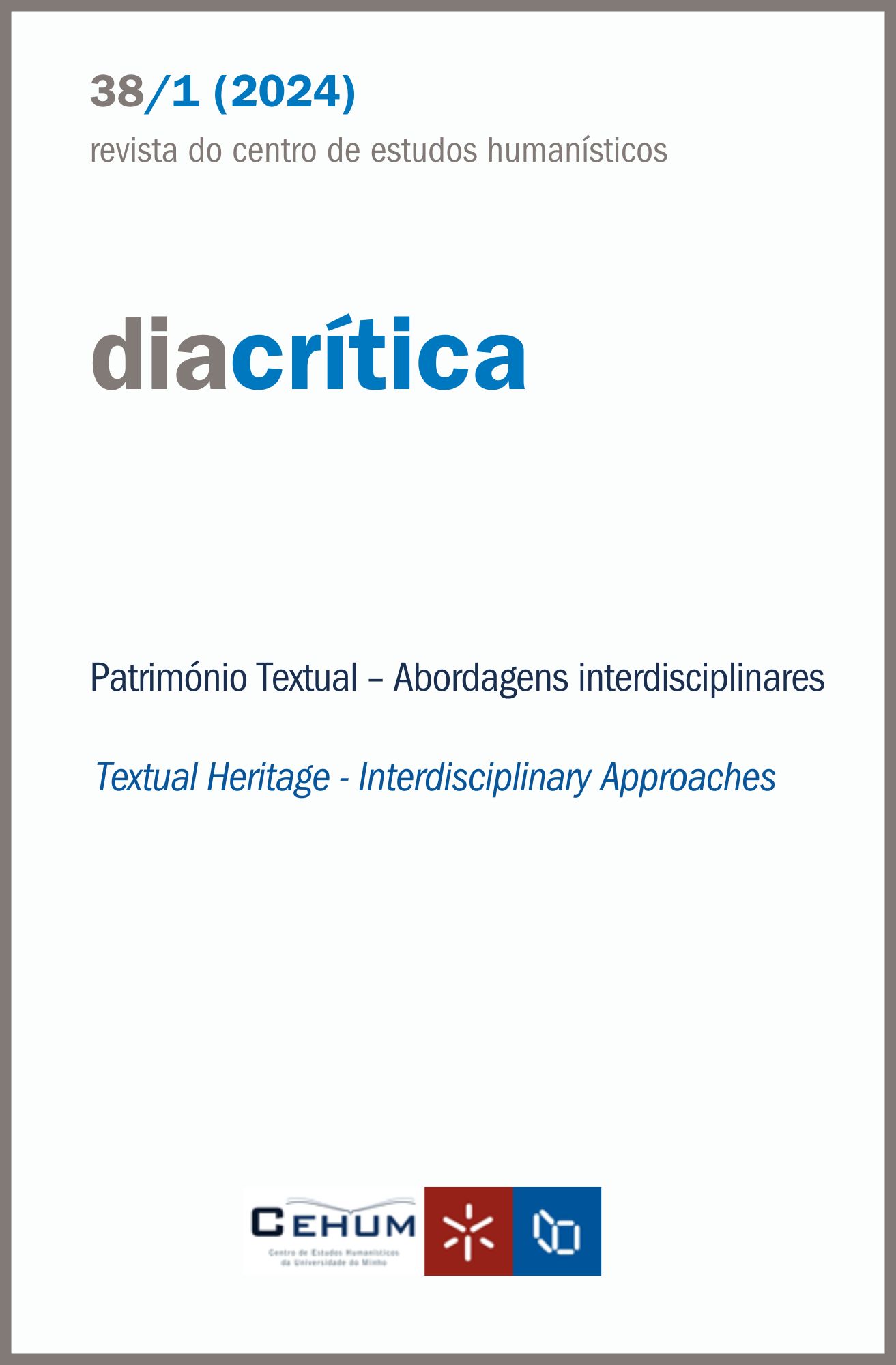The materiality of typescripts in Pedro Homem de Mello’s writing practice
DOI:
https://doi.org/10.21814/diacritica.5594Keywords:
Typewriter, Creativity, Revision, Genetic Criticism, Modernism, PortugalAbstract
This article addresses the main typewriting habits of Portuguese poet Pedro Homem de Mello (1904–1984), as evidenced in documents belonging to the family’s private estate and scattered collections owned by public archives and libraries. After examining his work in several spheres of activity (his personal and professional correspondence, his newspaper collaborations and essays as a folklorist, and his work as an author and presenter of TV and radio programs), the essay focuses on material aspects of Homem de Mello’s literary typescripts, such as page management strategies, the use of coloured ribbons, the occurrence of mechanical errors, or the combination of handwritten corrections and carbon-paper duplicators as a favoured revision technique. It concludes by interrogating how the author’s multimodal typewriting ecosystem may have contributed to stylistic changes in his poetry, catalysing freer modes of expression in the traditional forms of his choice.
References
Cooper, M. M. (1986). The ecology of writing. College English, 48(4), 364–375. https://doi.org/10.2307/377264 DOI: https://doi.org/10.58680/ce198611607
Côrte-Real, M. S. J. (2002). Musical priorities in the cultural policy of Estado Novo. Revista Portuguesa de Musicologia, 12, 227–252. https://rpm-ns.pt/index.php/rpm/article/view/117
De Biasi, P.-M. (1999). Editing manuscripts: Towards a typology of recent French genetic editions: 1980–1995 (H. Erlichson, Trans.). Text: An Interdisciplinary Annual of Textual Studies, 12, 1–30.
Decreto-lei no. 27:868 da Presidência do Conselho (1937, July 17). Diário do Govêrno: série I, no. 165/1937, p. 691. https://files.diariodarepublica.pt/1s/1937/07/16500/06910692.pdfDionísio, J. (2021). Doença bibliográfica. Imprensa Nacional.
Eliot, T. S. (2009). The letters of T. S. Eliot: Volume I, 1898–1922 (V. Eliot & H. Haughton, Eds.). Faber & Faber.
Greg, W. W. (1951). The rationale of copy-text. Studies in Bibliography, 3, 19–36. http://bsuva.org/wordpress/studies-in-bibliography
Grésillon, A. (1989). Fonctions du langage et genèse du texte. In L. Hay (Ed.), La naissance du texte (pp. 177–192). José Corti.
Guimarães, F. (1982). Simbolismo, modernismo e vanguardas. IN–CM.
Hay, L. (2017). Genetic criticism: Another approach to writing? In S. Plane, C. Bazerman, F. Rondelli, C. Donahue, A. N. Applebee, C. Boré, P. Carlino, M. M. Larruy, P. Rogers & D. Russell (Eds.), Research on writing: Multiple perspectives (pp. 531–547). The WAC Clearinghouse. https://doi.org/10.37514/INT-B.2017.0919.2.29 DOI: https://doi.org/10.37514/INT-B.2017.0919.2.29
Kittler, F. A. (1990). Discourse networks: 1800/1900 (M. Meteer & C. Cullens, Trans.). Stanford University Press. DOI: https://doi.org/10.1515/9781503621633
Kittler, F. A. (1999). Gramophone, film, typewriter (G. Winthorp-Young & M. Wutz, Trans.). Stanford University Press.
Layne, M. K. (2014). The textual ecology of the Palimpsest: Environmental entanglement of present and past. Aisthesis, 2, 63–72. https://doi.org/10.13128/Aisthesis-15290
Lodge, D. (2011). Therapy. Vintage Books.
Lyons, M. (2021). The typewriter century: A cultural history of writing practices. University of Toronto Press. DOI: https://doi.org/10.3138/9781487537821
Mahrer, R., R., Angelis, A., Lungo, A. Grésillon, A., Lebrave, J.-L., Saraillon, V. N., Poibeau, T., Mélanie-Becquet, F., & Vauthier, B. (2015). Editorial genesis: From comparing texts (product) to interpreting rewritings (process). In G. Cislaru (Ed.), Writing(s) at the crossroads: The process-product interface (pp. 151–170). John Benjamins Publishing Company. https://doi.org/10.1075/z.194.08mah DOI: https://doi.org/10.1075/z.194.08mah
Mello, P. H. (1926). Não choreis os mortos. Soberania do Povo, 4414, 2.
Mello, P. H. (1938, March). Confissão. Romance. Ascensão. Presença. Dansa velada. Presença, 3(51).
Mello, P. H. (1938, November). Fuga. Dúvida. Vendo rir Cleópatra. Presença, 3(53/54).
Mello, P. H. (1953, June). Solidão. Ler, 2(15), 5.
Mello, P. H. (1974). Ecce Homo. [n.p.].
Mello, P. H. (2007). Eu, poeta e tu, cidade. Quasi Edições.
Monteiro, A. C. (2003). A poesia da ‘Presença’: Estudo e antologia. Livros Cotovia.
Neidigh, S. A. (1919). Bicolored typewriter-ribbon and process of making the same. Patented in January 1921. https://patents.google.com/patent/US1364788A/en
Pereira, E. (2018). Erros de autor em testemunhos dactilográficos: Para uma edição digital da poesia de Pedro Homem de Mello. CEM: Cultura, Espaço & Memória, 9, 275–285. http://ojs.letras.up.pt/index.php/CITCEM/article/view/6231
Pereira, E. (2023) Authors’ rights vs. textual scholarship: A Portuguese overview. Journal of Intellectual Property, Information Technology and E-Commerce Law, 14(4), 510-524. https://www.jipitec.eu/jipitec/article/view/19
Pessoa, F. (1985). Cartas de Fernando Pessoa a Armando Côrtes-Rodrigues (J. Serrão, Introd.). Livros Horizonte.
Pessoa, F. (1993). Poesias de Álvaro de Campos. Ática.
Pessoa, F. (1999). Correspondência 1923-1935 (M. P. Silva, Ed.). Assírio & Alvim.
Pinheiro, A. (2021a). Messa, a marca portuguesa. Computatio Lusitana. Retrieved April 27, 2024, from https://computatiolusitana.wordpress.com/2021/08/27/messa-a-marca-portuguesa
Pinheiro, A. (2021b). As teclas que enganaram Salazar. Computatio Lusitana. Retrieved April 27, 2024, from https://computatiolusitana.wordpress.com/2021/03/24/as-teclas-que-enganaram-salazar/
Pulkkinen, V. (2020a). The taming of matter: Jalmari Finne and the typewriter. Textual Cultures, 13(2), 197–228. https://doi.org/10.14434/textual.v13i2.31601 DOI: https://doi.org/10.14434/textual.v13i2.31601
Pulkkinen, V. (2020b). The diary, the typewriter and representative reality in the genesis of Juha Mannerkorpi’s Päivänsinet. European Journal of Life Writing, 9, 1–21. https://doi.org/10.21827/ejlw.9.35712 DOI: https://doi.org/10.21827/ejlw.9.35712
Pulkkinen, V. (2023). A curious thing: Typescripts and genetic criticism. In S. Katajamäki, V. Pulkkinen & T. Dunderlin (Eds.), Genetic riticism in motion: New perspectives on manuscript studies (pp. 33–57). Finnish Literature Society. https://doi.org/10.21435/sflit.14 DOI: https://doi.org/10.21435/sflit.14
Rainey, L. (2005). Revisiting “The Waste Land”. Yale University Press.
Sena, J. (1977). Régio, casais, a “Presença” e outros afins. Brasília Editora.
Silvestre, O. M. (2003). Prefácio. In A. C. Monteiro, A poesia da ‘Presença’: Estudo e antologia (pp. 13–22). Livros Cotovia.
Sullivan, H. (2013). The work of revision. Harvard University Press.
Tanselle, G. T. (1990). Textual criticism and editing. University Press of Virginia.
Viollet, C. (1996). Écriture mécanique, espaces de frappe : Quelques préalables à une sémiologie du dactylogramme. Genesis, 10, 193–208. https://www.persee.fr/doc/item_1167-5101_1996_num_10_1_1075 DOI: https://doi.org/10.3406/item.1996.1075
Wellbery, D. E. (1990). Foreword. In F. A. Kittler, Discourse networks 1800 / 1900 (pp. vii–xxxiii). Stanford University Press. DOI: https://doi.org/10.1515/9781503621633-001
Weston, D. (2016). Contemporary poetic ecologies and a return to form. C21 Literature: Journal of 21st-Century Writings, 4(1), 5. https://doi.org/10.16995/c21.5 DOI: https://doi.org/10.16995/c21.5
Wutz, M. & G. Winthrop-Young. (1999). Translator’s introduction. In F. A. Kittler, Gramophone, film, typewriter (pp. xi–xxxviii). Stanford University Press.
Downloads
Published
How to Cite
Issue
Section
License
Copyright (c) 2024 Elsa Pereira

This work is licensed under a Creative Commons Attribution-NonCommercial 4.0 International License.
Funding data
-
Fundação para a Ciência e a Tecnologia
Grant numbers https://doi.org/10.54499/DL57/2016/CP1443/CT0033 -
Fundação para a Ciência e a Tecnologia
Grant numbers https://doi.org/10.54499/UIDB/00214/2020










